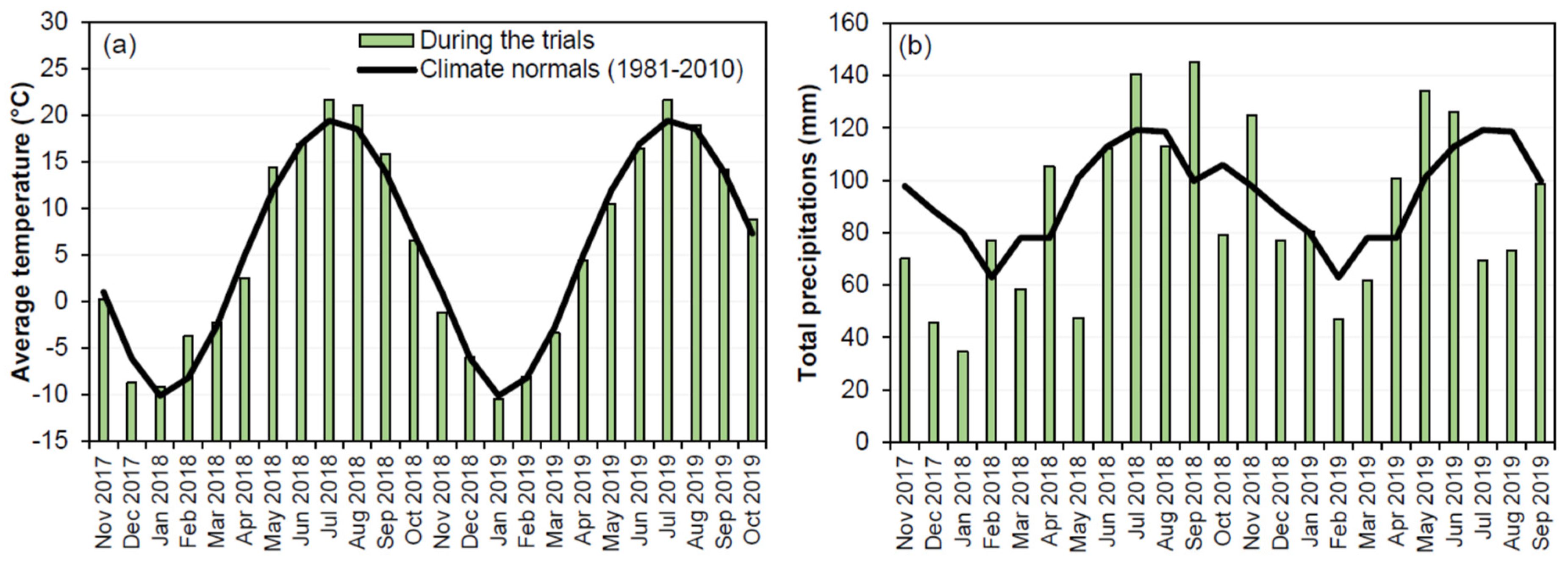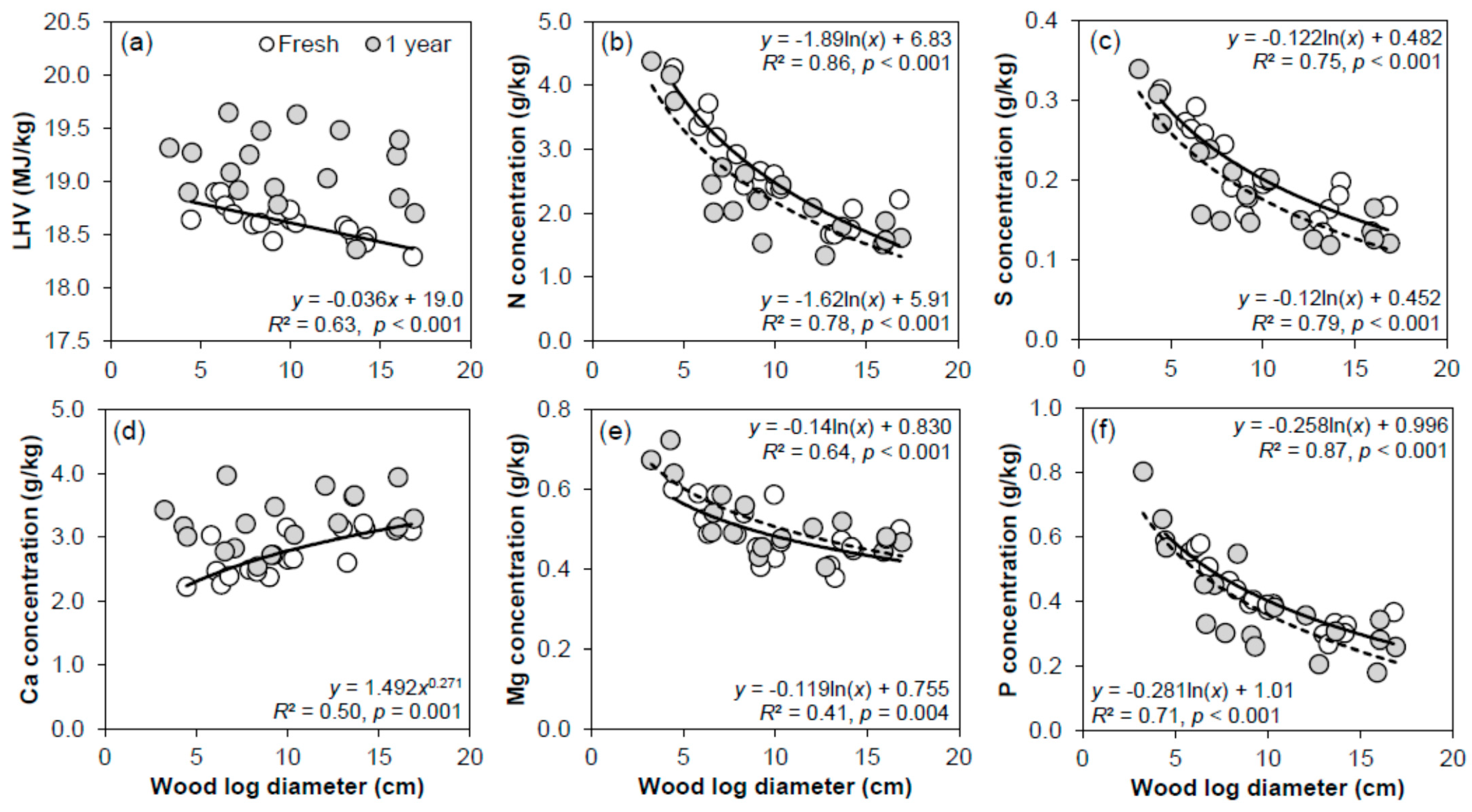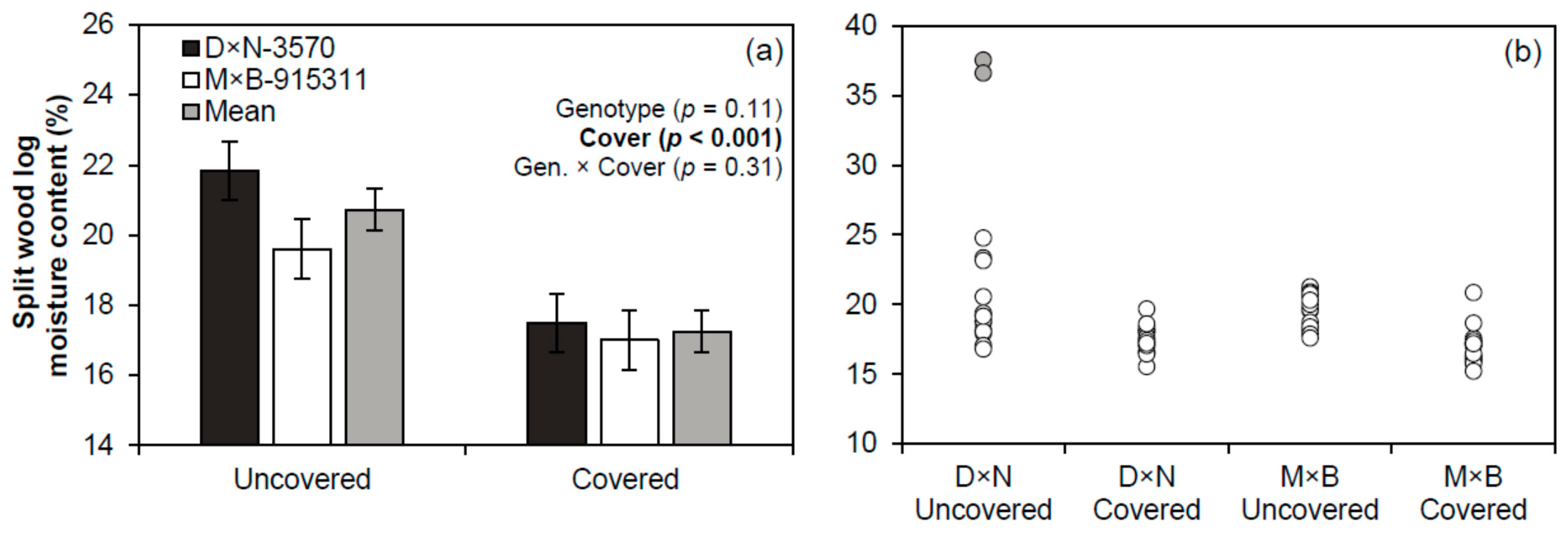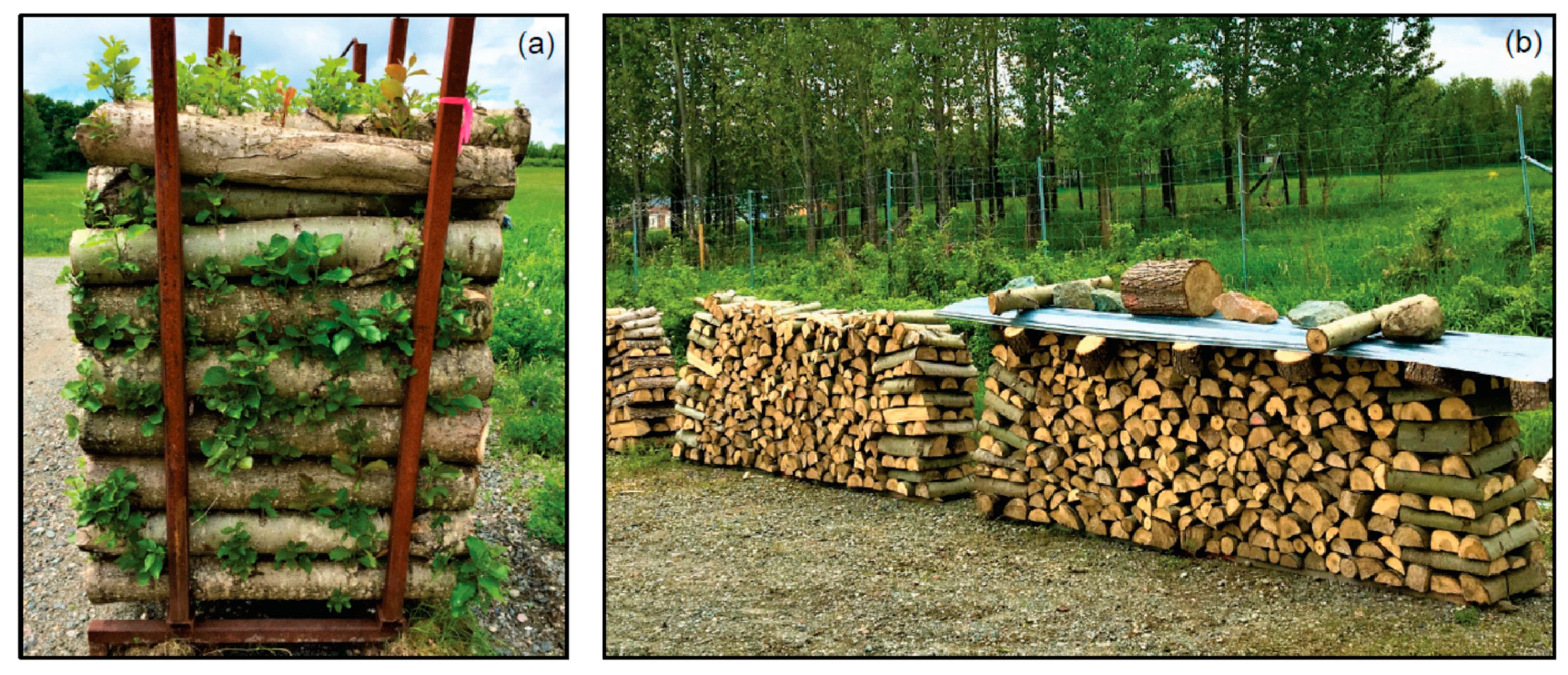Natural Drying and Chemical Characteristics of Hybrid Poplar Firewood Produced from Agricultural Bioenergy Buffers in Southern Québec, Canada
Abstract
1. Introduction
2. Materials and Methods
2.1. Site Description
2.2. Firewood Harvesting, Processing and Sampling
2.2.1. Trial A—110 cm Long Unsplit Wood Logs
2.2.2. Trial B—40 cm Long Split Wood Log
2.3. Meteorological Data during the Trials
2.4. Chemical Analyses of Firewood
2.5. Statistical Analyses
2.5.1. Trial A
2.5.2. Trial B
3. Results
3.1. Trial A
3.2. Trial B
4. Discussion
5. Conclusions
Author Contributions
Funding
Data Availability Statement
Acknowledgments
Conflicts of Interest
References
- Manzone, M. Energy and moisture losses during poplar and black locust logwood storage. Fuel Process. Technol. 2015, 138, 194–201. [Google Scholar] [CrossRef]
- Côté, M.-A.; Gilbert, D.; Nadeau, S. Characterizing the profiles, motivations and behaviour of Quebec’s forest owners. For. Policy Econ. 2015, 59, 83–90. [Google Scholar] [CrossRef]
- Doornbos, J.; Richardson, J.; van Oosten, C. Activities related to poplar and willow cultivation and utilization in Canada. In Canadian Report to the 25th Session of the International Poplar Commission; Poplar and Willow Council of Canada: Edmonton, AB, Canada, 2016. [Google Scholar]
- Butler, B.J.; Hewes, J.H.; Dickinson, B.J.; Andrejczyk, K.; Butler, S.M.; Markowski-Lindsay, M. Family forest ownerships of the united states, 2013: Findings from the USDA Forest Service’s national woodland owner survey. J. For. 2016, 114, 638–647. [Google Scholar] [CrossRef]
- Jobin, B.; Latendresse, C.; Baril, A.; Maisonneuve, C.; Boutin, C.; Côté, D. A half-century analysis of landscape dynamics in southern Québec, Canada. Environ. Monit. Assess. 2014, 186, 2215–2229. [Google Scholar] [CrossRef] [PubMed]
- Kaushal, S.S.; Mayer, P.M.; Vidon, P.G.; Smith, R.M.; Pennino, M.J.; Newcomer, T.A.; Duan, S.; Welty, C.; Belt, K.T. Land use and climate variability amplify carbon, nutrient, and contaminant pulses: A review with management implications. JAWRA 2014, 50, 585–614. [Google Scholar] [CrossRef]
- Schoeneberger, M.M.; Bentrup, G.; Patel-Weynand, T. Agroforestry: Enhancing Resiliency in U.S. Agricultural Landscapes under Changing Conditions; U.S. Department of Agriculture, Forest Service: Washington, DC, USA, 2017; p. 228.
- Fortier, J.; Truax, B.; Gagnon, D.; Lambert, F. Soil nutrient availability and microclimate are influenced more by genotype than by planting stock type in hybrid poplar bioenergy buffers on farmland. Ecol. Engin. 2020, 157, 105995. [Google Scholar] [CrossRef]
- Truax, B.; Fortier, J.; Gagnon, D.; Lambert, F. Long-term effects of white-tailed deer overabundance, hybrid poplar genotype and planting stock type on tree growth and ecosystem services provision in bioenergy buffers. For. Ecol. Manag. 2021, 480, 118673. [Google Scholar] [CrossRef]
- Ferrarini, A.; Serra, P.; Almagro, M.; Trevisan, M.; Amaducci, S. Multiple ecosystem services provision and biomass logistics management in bioenergy buffers: A state-of-the-art review. Renew. Sustain. Energy Rev. 2017, 73, 277–290. [Google Scholar] [CrossRef]
- Fortier, J.; Truax, B.; Gagnon, D.; Lambert, F. Potential for hybrid poplar riparian buffers to provide ecosystem services in three watersheds with contrasting agricultural land use. Forests 2016, 7, 37. [Google Scholar] [CrossRef]
- Schultz, R.C.; Isenhart, T.M.; Simpkins, W.W.; Colletti, J.P. Riparian forest buffers in agroecosystems—lessons learned from the Bear Creek Watershed, central Iowa, USA. Agrofor. Syst. 2004, 61–62, 35–50. [Google Scholar]
- Truax, B.; Gagnon, D.; Lambert, F.; Fortier, J. Multiple-use zoning model for private forest owners in agricultural landscapes: A case study. Forests 2015, 6, 3614–3664. [Google Scholar] [CrossRef]
- Fortier, J.; Truax, B.; Gagnon, D.; Lambert, F. Mature hybrid poplar riparian buffers along farm streams produce high yields in response to soil fertility assessed using three methods. Sustainability 2013, 5, 1893–1916. [Google Scholar] [CrossRef]
- Truax, B.; Gagnon, D.; Fortier, J.; Lambert, F. Biomass and volume yield in mature hybrid poplar plantations on temperate abandoned farmland. Forests 2014, 5, 3107–3130. [Google Scholar] [CrossRef]
- Krigstin, S.; Wetzel, S. A review of mechanisms responsible for changes to stored woody biomass fuels. Fuel 2016, 175, 75–86. [Google Scholar] [CrossRef]
- Dzurenda, L.; Banski, A. The effect of firewood moisture content on the atmospheric thermal load by flue gases emitted by a boiler. Sustainability 2019, 11, 284. [Google Scholar] [CrossRef]
- Nord-Larsen, T.; Bergstedt, A.; Farver, O.; Heding, N. Drying of firewood—the effect of harvesting time, tree species and shelter of stacked wood. Biomass Bioenergy 2011, 35, 2993–2998. [Google Scholar] [CrossRef]
- United State Environmental Protection Agency. Burn Wise. Available online: https://www.epa.gov/burnwise (accessed on 9 November 2020).
- Manzone, M. Performance evaluation of different techniques for firewood storage in Southern Europe. Biomass Bioenergy 2018, 119, 22–30. [Google Scholar] [CrossRef]
- Kim, D.-W.; Murphy, G. Forecasting air-drying rates of small Douglas-fir and hybrid poplar stacked logs in Oregon, USA. Int. J. For. Eng. 2013, 24, 137–147. [Google Scholar] [CrossRef]
- Visser, R.; Berkett, H.; Spinelli, R. Determining the effect of storage conditions on the natural drying of radiata pine logs for energy use. N. Z. J. For. Sci. 2014, 44, 3. [Google Scholar] [CrossRef]
- Röser, D.; Mola-Yudego, B.; Sikanen, L.; Prinz, R.; Gritten, D.; Emer, B.; Väätäinen, K.; Erkkilä, A. Natural drying treatments during seasonal storage of wood for bioenergy in different European locations. Biomass Bioenergy 2011, 35, 4238–4247. [Google Scholar] [CrossRef]
- Lee, J.S.; Sokhansanj, S.; Lau, A.K.; Lim, C.J.; Bi, X.T.; Basset, V.; Yazdanpanah, F.; Melin, S.O. The effects of storage on the net calorific value of wood pellets. Can. Biosyst. Eng. 2015, 57, 5–12. [Google Scholar] [CrossRef]
- Obernberger, I.; Brunner, T.; Bärnthaler, G. Chemical properties of solid biofuels—Significance and impact. Biomass Bioenergy 2006, 30, 973–982. [Google Scholar] [CrossRef]
- Ravishankara, A.R.; Daniel, J.S.; Portmann, R.W. Nitrous oxide (N2O): The dominant ozone-depleting substance emitted in the 21st century. Science 2009, 326, 123. [Google Scholar] [CrossRef] [PubMed]
- Heil, J.; Vereecken, H.; Brüggemann, N. A review of chemical reactions of nitrification intermediates and their role in nitrogen cycling and nitrogen trace gas formation in soil. Eur. J. Soil Sc. 2016, 67, 23–39. [Google Scholar]
- Rodríguez-Soalleiro, R.; Eimil-Fraga, C.; Gómez-García, E.; García-Villabrille, J.D.; Rojo-Alboreca, A.; Muñoz, F.; Oliveira, N.; Sixto, H.; Pérez-Cruzado, C. Exploring the factors affecting carbon and nutrient concentrations in tree biomass components in natural forests, forest plantations and short rotation forestry. For. Ecosyst. 2018, 5, 35. [Google Scholar] [CrossRef]
- Augusto, L.; Meredieu, C.; Bert, D.; Trichet, P.; Porté, A.; Bosc, A.; Lagane, F.; Loustau, D.; Pellerin, S.; Danjon, F.; et al. Improving models of forest nutrient export with equations that predict the nutrient concentration of tree compartments. Ann. For. Sci. 2008, 65, 808. [Google Scholar]
- Robitaille, A.; Saucier, J.-P. Paysages Régionaux du Québec Méridional; Les Publications du Québec: Ste-Foy, QC, Canada, 1998; p. 213.
- Government of Canada. Station Results—1981–2010. Climate Normals and Averages. Available online: http://climate.weather.gc.ca/climate_normals/station_select_1981_2010_e.html?searchType=stnProv&lstProvince=QC (accessed on 11 May 2020).
- Government of Canada. Historical Climate Data. Available online: https://climate.weather.gc.ca/index_e.html (accessed on 11 May 2020).
- Manikandan, S. Data transformation. J. Pharm. Pharm. 2010, 1, 126–127. [Google Scholar] [CrossRef]
- Petersen, R.G. Use and misuse of multiple comparison procedures. Agron. J. 1977, 69, 205–208. [Google Scholar] [CrossRef]
- Royston, P. An extension of Shapiro and Wilk’s W test for normality to large samples. Appl. Stat. 1982, 31, 115–124. [Google Scholar] [CrossRef]
- Chambers, J.M.; Cleveland, W.S.; Kleiner, B.; Tukey, P.A. Graphical Methods for Data Analysis; Wadsworth International Group: Belmont, CA, USA, 1983. [Google Scholar]
- Spartz, J.T. A Hot Debate: Stacking Firewood Bark Up or Bark Down? Lab Note. News from the Forest Products Laboratory. USDA Forests Service. Available online: https://www.fpl.fs.fed.us/labnotes/?p=436#:~:text=If%20split%20wood%20is%20stored,and%20accelerate%20decay%2C%20says%20Knaebe (accessed on 19 January 2021).
- Erber, G.; Huber, C.; Stampfer, K. To split or not to split: Feasibility of pre-storage splitting of large poplar (Populus spp. L.) fuelwood logs. Fuel 2018, 220, 817–825. [Google Scholar] [CrossRef]
- Fortier, J.; Truax, B.; Gagnon, D.; Lambert, F. Allometric equations for estimating compartment biomass and stem volume in mature hybrid poplars: General or site-specific? Forests 2017, 8, 309. [Google Scholar] [CrossRef]
- Wallenstein Equipment Inc. Splitter Model WX330 Horizontal Tractor. Available online: https://www.wallensteinequipment.com/ca/en/model/wx330 (accessed on 15 January 2021).
- Balatinecz, J.; Mertens, P.; de Boever, L.; Yukun, H.; Jin, J.; van Acker, J. 10 Properties, processing and utilization. In Poplar and Willows: Tree for the Society and the Environment; Isebrands, J.G., Richardson, J., Eds.; CAB Interantional and FAO: Rome, Italy, 2014; pp. 527–561. [Google Scholar]
- Stutter, M.; Kronvang, B.; Ó hUallacháin, D.; Rozemeijer, J. Current insights into the effectiveness of riparian management, attainment of multiple benefits, and potential technical enhancements. J. Environ. Qual. 2019, 48, 236–247. [Google Scholar] [CrossRef] [PubMed]
- Carmona, R.; Nuñez, T.; Alonso, M.F. Biomass yield and quality of an energy dedicated crop of poplar (Populus spp.) clones in the Mediterranean zone of Chile. Biomass Bioenergy 2015, 74, 96–102. [Google Scholar] [CrossRef]
- Myeong, S.-J.; Han, S.-H.; Shin, S.-J. Analysis of chemical compositions and energy contents of different parts of yellow poplar for development of bioenergy technology. J. Korean For. Soc. 2010, 99, 706–710. [Google Scholar]
- Therasme, O.; Eisenbies, M.H.; Volk, T.A. Overhead protection increases fuel quality and natural drying of leaf-on woody biomass storage piles. Forests 2019, 10, 390. [Google Scholar] [CrossRef]
- Nurmi, J. The storage of logging residue for fuel. Biomass Bioenergy 1999, 17, 41–47. [Google Scholar] [CrossRef]
- Rytter, L. Nutrient content in stems of hybrid aspen as affected by tree age and tree size, and nutrient removal with harvest. Biomass Bioenergy 2002, 23, 13–25. [Google Scholar] [CrossRef]
- Matthews, S. Effect of drying temperature on fuel moisture content measurements. Int. J. Wildland Fire 2010, 19, 800–802. [Google Scholar] [CrossRef]
- Fortier, J.; Gagnon, D.; Truax, B.; Lambert, F. Nutrient accumulation and carbon sequestration in 6 year-old hybrid poplars in multiclonal agricultural riparian buffer strips. Agric. Ecosyst. Environ. 2010, 137, 276–287. [Google Scholar] [CrossRef]
- Rashin, E.B.; Clishe, C.J.; Loch, A.T.; Bell, J.M. Effectiveness of timber harvest practices for controlling sediment related water quality impacts. JAWRA 2006, 42, 1307–1327. [Google Scholar] [CrossRef]








| Trial A—Unsplit 110 cm Long Logs (Hybrid Poplar, Trembling Aspen, Red Maple, White Ash) | Dates |
| Tree felling and log processing | 7–14 November 2017 |
| Log stacking in metal racks | 14 November 2017 |
| Outdoor seasoning | 14 November 2017–4 November 2018 |
| Warehouse seasoning (unheated) | 4 November 2018–22 October 2019 |
| Chemistry sampling (fresh, hybrid poplar only) | 7–14 November 2017 |
| Chemistry and moisture sampling (after 1 year, 4 species) | 6 November 2018 |
| Moisture sampling (after 2 years, 4 species) | 22 October 2019 |
| Trial B—Split 40 cm Long Logs (2 Hybrid Poplar Genotypes × 2 Cover Treatments) | Dates |
| Tree felling and moisture sampling | 5–9 November 2018 |
| Log processing and splitting | 22 May 2019 |
| Log stacking | 23 May 2019 |
| Outdoor seasoning | 5–9 November 2018–22 October 2019 |
| Moisture sampling (after 1 year) | 22 October 2019 |
| LHVdry (MJ/kg) | C (g/kg) | N (g/kg) | S (g/kg) | P (g/kg) | K (g/kg) | Ca (g/kg) | Mg (g/kg) | |||||||||
|---|---|---|---|---|---|---|---|---|---|---|---|---|---|---|---|---|
| Diameter Class | Fresh | 1 year | Fresh | 1 year | Fresh | 1 year | Fresh | 1 year | Fresh | 1 year | Fresh | 1 year | Fresh | 1 year | Fresh | 1 year |
| 3.0–7.9 cm | 18.75 | 19.19 | 507.1 | 519.3 | 3.50 | 3.25 | 0.274 | 0.258 | 0.544 | 0.544 | 1.80 | 1.85 | 2.48 | 3.20 | 0.547 | 0.610 |
| 8.0–12.9 cm | 18.62 | 19.19 | 512.5 | 521.3 | 2.46 | 2.15 | 0.187 | 0.173 | 0.398 | 0.358 | 1.85 | 1.75 | 2.67 | 3.13 | 0.481 | 0.486 |
| ≥13 cm | 18.47 | 19.00 | 514.8 | 515.0 | 1.85 | 1.62 | 0.166 | 0.132 | 0.316 | 0.263 | 2.05 | 1.96 | 3.14 | 3.40 | 0.444 | 0.466 |
| S.E. Class | 0.05 | 0.15 | 3.2 | 1.6 | 0.13 | 0.25 | 0.009 | 0.017 | 0.015 | 0.049 | 0.10 | 0.16 | 0.12 | 0.17 | 0.023 | 0.025 |
| p-value Class | 0.002 | 0.60 | 0.24 | 0.04 | <0.001 | 0.001 | <0.001 | <0.001 | <0.001 | 0.003 | 0.21 | 0.69 | 0.005 | 0.54 | 0.02 | 0.002 |
| Mean | 18.61 | 19.13 | 511.5 | 518.5 | 2.60 | 2.34 | 0.209 | 0.188 | 0.419 | 0.388 | 1.90 | 1.85 | 2.76 | 3.24 | 0.490 | 0.521 |
| S.E. Drying | 0.06 | 1.4 | 0.12 | 0.008 | 0.021 | 0.08 | 0.09 | 0.014 | ||||||||
| p-value Drying | <0.001 | 0.002 | 0.12 | 0.02 | 0.07 | 0.68 | <0.001 | 0.13 | ||||||||
| p-value Class × Drying | 0.82 | 0.06 | 0.98 | 0.46 | 0.61 | 0.82 | 0.32 | 0.47 | ||||||||
| Tree Species | Diameter (cm) | LHVdry (MJ/kg) | C (g/kg) | N (g/kg) | S (g/kg) | P (g/kg) | K (g/kg) | Ca (g/kg) | Mg (g/kg) |
|---|---|---|---|---|---|---|---|---|---|
| H. poplar | 12.3 ± 1.1 | 19.09 ± 0.08 | 518.1 ± 1.2 | 1.89 ± 0.12 | 0.153 ± 0.008 b | 0.310 ± 0.020 a | 1.85 ± 0.08 a | 3.27 ± 0.14 a | 0.476 ± 0.016 a |
| T. aspen | 13.3 ± 1.6 | 18.92 ± 0.12 | 517.5 ± 1.6 | 1.65 ± 0.18 | 0.133 ± 0.012 b | 0.167 ± 0.029 b | 0.94 ± 0.12 b | 3.14 ± 0.19 a | 0.278 ± 0.023 b |
| R. maple | 12.4 ± 1.6 | 18.75 ± 0.12 | 520.3 ± 1.6 | 1.84 ± 0.18 | 0.139 ± 0.012 b | 0.247 ± 0.029 ab | 1.08 ± 0.12 b | 1.82 ± 0.19 b | 0.193 ± 0.023 b |
| W. ash | 12.9 ± 1.6 | 18.88 ± 0.12 | 520.7 ± 1.6 | 1.94 ± 0.18 | 0.199 ± 0.012 a | 0.180 ± 0.029 b | 1.73 ± 0.12 a | 2.63 ± 0.19 a | 0.252 ± 0.023 b |
| p-value | 0.96 | 0.12 | 0.40 | 0.64 | 0.002 | <0.001 | <0.001 | <0.001 | <0.001 |
Publisher’s Note: MDPI stays neutral with regard to jurisdictional claims in published maps and institutional affiliations. |
© 2021 by the authors. Licensee MDPI, Basel, Switzerland. This article is an open access article distributed under the terms and conditions of the Creative Commons Attribution (CC BY) license (http://creativecommons.org/licenses/by/4.0/).
Share and Cite
Fortier, J.; Truax, B.; Gagnon, D.; Lambert, F. Natural Drying and Chemical Characteristics of Hybrid Poplar Firewood Produced from Agricultural Bioenergy Buffers in Southern Québec, Canada. Forests 2021, 12, 122. https://doi.org/10.3390/f12020122
Fortier J, Truax B, Gagnon D, Lambert F. Natural Drying and Chemical Characteristics of Hybrid Poplar Firewood Produced from Agricultural Bioenergy Buffers in Southern Québec, Canada. Forests. 2021; 12(2):122. https://doi.org/10.3390/f12020122
Chicago/Turabian StyleFortier, Julien, Benoit Truax, Daniel Gagnon, and France Lambert. 2021. "Natural Drying and Chemical Characteristics of Hybrid Poplar Firewood Produced from Agricultural Bioenergy Buffers in Southern Québec, Canada" Forests 12, no. 2: 122. https://doi.org/10.3390/f12020122
APA StyleFortier, J., Truax, B., Gagnon, D., & Lambert, F. (2021). Natural Drying and Chemical Characteristics of Hybrid Poplar Firewood Produced from Agricultural Bioenergy Buffers in Southern Québec, Canada. Forests, 12(2), 122. https://doi.org/10.3390/f12020122







